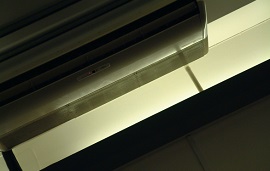Many of us enjoy the benefits of having an air conditioning system in our homes. Few people understand how these systems work in principle and this is unfortunate. Even a basic understanding of how your system works can help in a number of ways, such as identifying faults, understanding your contractor and naming parts. One of the key parts in any air conditioner is the air handler, and here we will take a closer look at how this works.
The Basic Anatomy:
You may have noticed that your central air system has two main parts that are located indoors and outdoors. The indoor part of your system is the air handler that is usually located in an attic or perhaps a closet. This is a metal container that houses a number of different components to run your air conditioning. Inside you will find parts, such as a filter rack, a filter, a heating source, a blower unit, electrical wiring and connectors, an evaporator coil and a front mounted vent. This vent is used to draw air into the system, where it is treated and then distributed throughout the home.
How the Air is Moved:
The air handler uses the blower unit to pull the air into the system, and it’s then assisted by the external unit. The outdoor unit moves pressurized refrigerant into the system, and the air handler then either cools or heats the air as specified by the setting on the thermostat. There are attached ducts; these allow the forced air to be moved around the home and then into the individual rooms. The air is then circulated back into the air handler to repeat the process cyclically. This process continues until the system is turned off or until there is a system failure of some kind.
Minimum Space Requirements:
Quite often, air handlers are located in very confined spaces, where the air movement is minimized. This is less than optimal, as sufficient air flow through the filter is required for the air handler to work correctly. This can be solved by using venting or filtering to alter the incoming airflow to make the air handler work better for heating and cooling the home. Another solution could be the installation of a different size of blower unit, and this is also a good option if there is also a humidity problem in the home.
Regular Maintenance and System Failures:
The air handler is a complex piece of equipment, and as such it requires periodic maintenance and repair to function correctly. One of the main problems is a buildup of dirt, dust, and debris on the coils and in the ducts. This can significantly hinder optimal operation, and it can lead to a loss in cooling and energy efficiency. Over time a neglected system will begin to fail regularly, and extensive repairs may be necessary. A well maintained system is less likely to break down, it will also work more efficiently and cost less to run.
